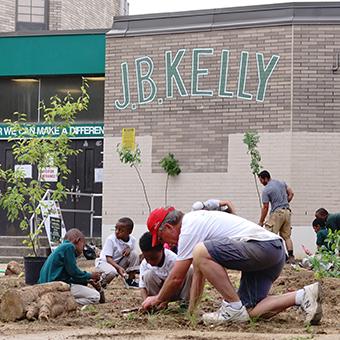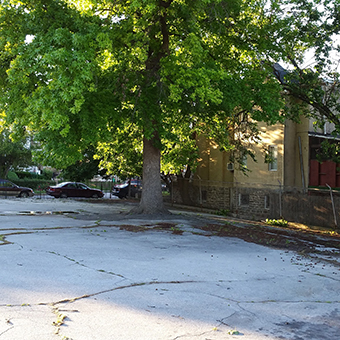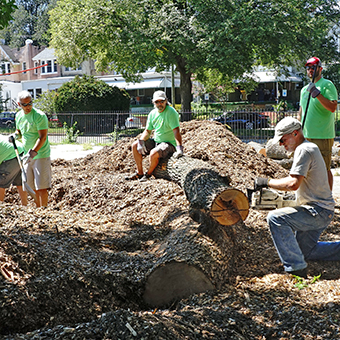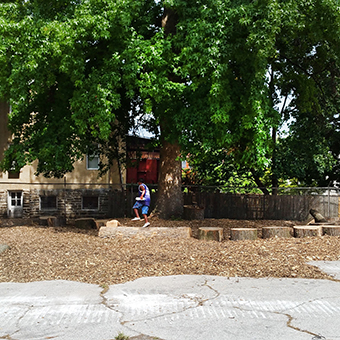
For Philadelphia Schoolyards, Going Green Isn't as Hard as It Looks
What do Emlen School in East Mt. Airy and Kelly School in Germantown have in common? They both have master plans for amazing schoolyard redevelopment projects that are not yet funded.
In the past several years, school communities have recognized the immense benefits of transitioning from the asphalt deserts that currently define most schoolyards to vibrant landscapes that encourage creativity, exploration, physical activity, healthy lifestyles and connection to nature. Such greenspaces become an amenity not just for the school, but for the surrounding community, improving a school’s “curb appeal” and public perceptions of the school.
However, these improvement projects come with hefty price tags: A complete school redevelopment project, such as at Lea in West Philadelphia or William Dick in Strawberry Mansion, have construction costs of over $500,000, and sometimes exceed the $1 million mark. The School District of Philadelphia has committed to funding as many of these projects as it can, but at most that might be a handful per year. With about 300 schools in the District, including charters, it may be a long time until every school with a vision sees any change, and many schools will have to take fundraising upon themselves, a mammoth task for already under-resourced operations.
LandHealth Institute, a Philadelphia-based nonprofit whose mission is to “Put Nature Back” and “Restore Connections,” believes the children of Philadelphia should not have to wait for a check to fall from the sky to have a schoolyard with access to nature and safe opportunities for outdoor play. “There are plenty of low-cost solutions that can have big impacts on the visual appearance of the school, create ties to curriculum and provide benefit to the environment,” said Sarah Endriss, Director of Development and Partnerships at LandHealth Institute. “You’d be amazed what is possible with a little bit of money and a lot of organizing.”
Kelly School, 5116 Pulaski Ave., has been working toward greening its schoolyard for more than four years with the strong leadership of the Kelly Green Project, an initiative of neighboring nonprofit Hansberry Garden and Nature Center. In June, LandHealth Institute worked with Kelly Green and Kelly School officials to coordinate the transformation of a weedy patch of grass in front of the school into an urban meadow planted by students and community members. The meadow features both native and “cosmopolitan” species and will serve as an educational resource for Kelly teachers and neighbors alike, as well as growing into a habitat and food source for birds and pollinators. This project attracted the support of the Friends of the Wissahickon, the Tookany/Tacony-Frankford Watershed Partnership and Audubon Pennsylvania. Audubon has since created a partnership with Kelly School and will be delivering lessons there using the meadow as its classroom.
LandHealth Institute has been working with Emlen School, 6501 Chew Ave., for nearly two years to bring green improvements to the schoolyard which currently consists of a shadeless expanse of asphalt and a basketball court. Last spring, Emlen received a grant of $5,000 from software company Maintenance Connection to build an improvement on the schoolyard that could be used for play or outdoor learning. LandHealth Institute designed and coordinated the installation (done almost entirely by volunteers) of a natural playscape and outdoor classroom area under the only tree in Emlen’s schoolyard – a beautiful mature sweet gum. This new amenity provides shady seating and three spaces for outdoor gathering and instruction, and can be used as an obstacle course and creative playscape. All materials for the project — including logs, stumps, wood chips and use of tools — were donated. (Thanks, Awbury Arboretum!)
These two projects, each costing $10,000 or less, exemplify what can be done with volunteer labor and a relatively small amount of money to quickly provide an amenity to students and communities. Creating real physical improvements can then generate momentum in the community for the bigger vision for the schoolyard. And replacing asphalt with native plants and natural surfaces benefits our urban environment, too.
If you’d like more information on how you or your business can support schoolyard transformation initiatives such as these, contact Sarah Endriss at LandHealth Institute at sarah@landhealthinstitute.org. All donations are tax-deductible.
Rachael Griffith (rachael@landhealthinstitute.org) is LandHealth Institute’s community programs manager.




